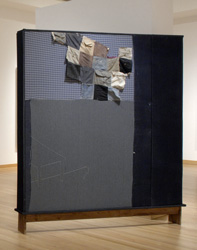Rashawn Griffin, Untitled (Boo Radley), 2006.
Born 1980 in Los Angeles, California; lives in New York, New York
Drawing from his training in sculpture and painting, Rashawn Griffin’s nostalgic assemblages use the architecture of the gallery space to reveal social landscapes and personal narratives. In the tradition of artists such as David Hammons and Bruce Conner, his diverse practice employs found objects and personal effects that introduce evocative hints of place and character. The dialogues Griffin creates between organic, transient materials including grasses and food and larger, architectural concerns engage the viewer as an active participant through fluctuations in scale and viewpoint.
Untitled (nat, love, baby!) (2006), exhibited in the 2006 artist-in-residence show Quid Pro Quo at the Studio Museum in Harlem, New York, includes a shattered pane of glass and reeds collected near the museum, a drawing and colorful pom-poms from his residency studio, a colored-pencil portrait with an indistinguishable face, and the artist’s copy of Marcel Proust’s Swann’s Way. Displayed on a shelf, this piece functions formally as a landscape, yet the individual elements hold strong personal and geographic resonance. The work also reads as a social panorama of Harlem, incorporating physical pieces from the environment into a specific narrative parallel to that of the artist. Like Proust, Griffin explores identity as a construct of objects, memories, and relationships—an idea perhaps echoed by the ambiguous portrait whose features, meaningless in isolation, recover meaning in the context of materials surrounding it.
In the 2005 exhibition Early February at Yale University’s Green Hall Gallery in New Haven, Connecticut, Griffin installed large canvases hung from the ceiling at eye level on the gallery’s entry floor. The monumental banners act as paintings, the environment of the public space lending them an official air. But the surfaces, covered with worn sheets and other fabrics, crudely hand stitched and stained, are imperfect, imbuing the works with an intimacy that belies their immediate impression of authority. Building on such antithetical notions, other banners incorporate newly purchased denim, a material with universal associations encompassing both high fashion and manual labor. Seen from below as the viewer descended into the gallery space, the panels shifted scale and dimension to become more sculptural. In the center of the gallery, what at first appeared to be a Minimalist brick box revealed itself as a framework covered with rows of Fig Newtons exuding a heavy, sweet fragrance. The handcrafted quality of the sculpture is emphasized by variegations in the color and shape of the mass-produced biscuits. Inevitably the work will rot and disintegrate, a failure that mirrors the deliberate imperfection of his monumental banners. Employing quiet reserve, this and other powerful works by Griffin reflect on the social landscape through personal gestures that translate to universally important concerns. STACEY GOERGEN
Rashawn Griffin, Untitled (Boo Radley), 2006. Pockets, blanket, fabric, wool, foam, artificial flower, cotton, and wood, 84 _ x 82 x 10 _ in. (215.3 x 208.3 x 26 cm). Private collection. Courtesy the artist.

























